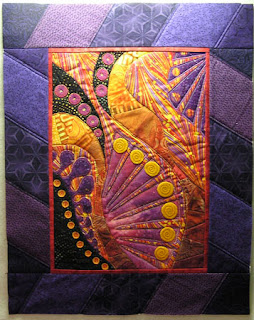Continuing with my Rooster pattern, here are the instructions on how to make the dimensional tail and wing feathers. Before I go over that, however, I was asked about the difference between fusible interfacing and fusible web. I often get this question from students because I do use both products. So I decided to go over it, hopefully well enough to understand.
Fusible interfacing is a nonwoven fabric with adhesive applied to one side that glues it to the fabric when pressed with a hot iron. It is generally used in shirt collars or other garments where fabric needs more body and some stiffness added to it.
Fusible web is a sheet of glue that is used to fuse fabric to fabric. There are several brands on the market and I have found that they all have their uses for various styles of quilting. It is usually backed with paper, although there a few without paper. The paper allows a pattern to be drawn on it so an applique shape can be cut out when pressed to fabric. This photo is a heavier fusible web, is paper backed, and a full sheet of glue.
This fusible web also comes with a paper backing but is more of a web of glue rather than a sheet. It is a lightweight fusible web.
Here is a piece of fabric with fusible web applied to the backside. Notice the difference between the left side which is the right side of the fabric and the right side which is the backside with fusible web. To make the Rooster tail and wing feathers, I use both fusible web and fusible interfacing. They are combined together to add stability for the stitching and thickness needed for the feathers to be dimensional.
I begin by cutting two pieces of the same fabric, one piece of fusible web and fusible interfacing all the same size of 3"x6."
Turning one piece of fabric wrong side up, place the fusible web on the fabric.
Place the fusible interfacing with the fusible side up.
Place the other fabric piece, right side up, on the stack. Press with no steam for approximately 5 seconds.
The tail feather pattern now needs to be traced onto the prepared fabric. To do that, I prepare the pattern piece by gluing the pattern piece that is rough cut onto a file folder (sorry my pattern is a bit messy:)).
Cut the pattern piece out on the line.
Place the pattern piece on the fabric and trace with a fine tip marker. I used a Pigma pen.
The tail feather will be outlined with satin stitching that will be done before the tail is cut out of the fabric.
Using my free-motion foot, I free-motion satin stitched around the pattern lines, taking the outside of the stitch outside of the pen to cover it up. The stitch width is 3.0.
With the stitching complete, cut the feathers out getting as close as possible to the stitching without cutting the threads. If you do happen to clip a thread, don't panic. Just use a little Fray Check to stop any possible unraveling.
And here you have a two-sided tail feather. When it is sewn to the Rooster, it will only be sewn down at the tail tip, leaving the remaining feather loose.
Until next time,





















































